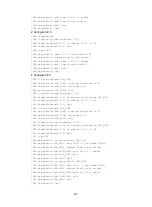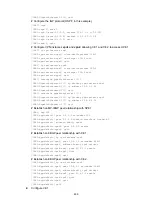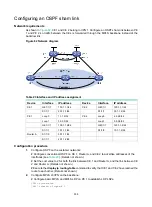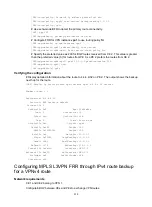
305
Configuring an OSPF sham link
Network requirements
As shown in
, CE 1 and CE 2 belong to VPN 1. Configure an OSPF sham link between PE
1 and PE 2 so traffic between the CEs is forwarded through the MPLS backbone instead of the
backdoor link.
Figure 82 Network diagram
Table 23 Interface and IP address assignment
Device
Interface
IP address
Device
Interface
IP address
CE 1
GE1/1/1
100.1.1.1/24
CE 2
GE1/1/1
120.1.1.1/24
S1/1/1
20.1.1.1/24
S1/1/1
30.1.1.2/24
PE 1
Loop0
1.1.1.9/32
PE 2
Loop0
2.2.2.9/32
Loop1
3.3.3.3/32
Loop1
5.5.5.5/32
GE1/1/1
100.1.1.2/24
GE1/1/1
120.1.1.2/24
S1/1/1
10.1.1.1/24
S1/1/0
10.1.1.2/24
Router
A
S1/1/0
30.1.1.1/24
S1/1/1
20.1.1.2/24
Configuration procedure
1.
Configure OSPF on the customer networks:
# Configure conventional OSPF on CE 1, Router A, and CE 2 to advertise addresses of the
interfaces (see
). (Details not shown.)
# Set the cost value to 2 for both the link between CE 1 and Router A, and the link between CE
2 and Router A. (Details not shown.)
# Execute the
display ip routing-table
command to verify that CE 1 and CE 2 have learned the
route to each other. (Details not shown.)
2.
Configure MPLS L3VPN on the backbone:
# Configure basic MPLS and MPLS LDP on PE 1 to establish LDP LSPs.
<PE1> system-view
[PE1] interface loopback 0
















































